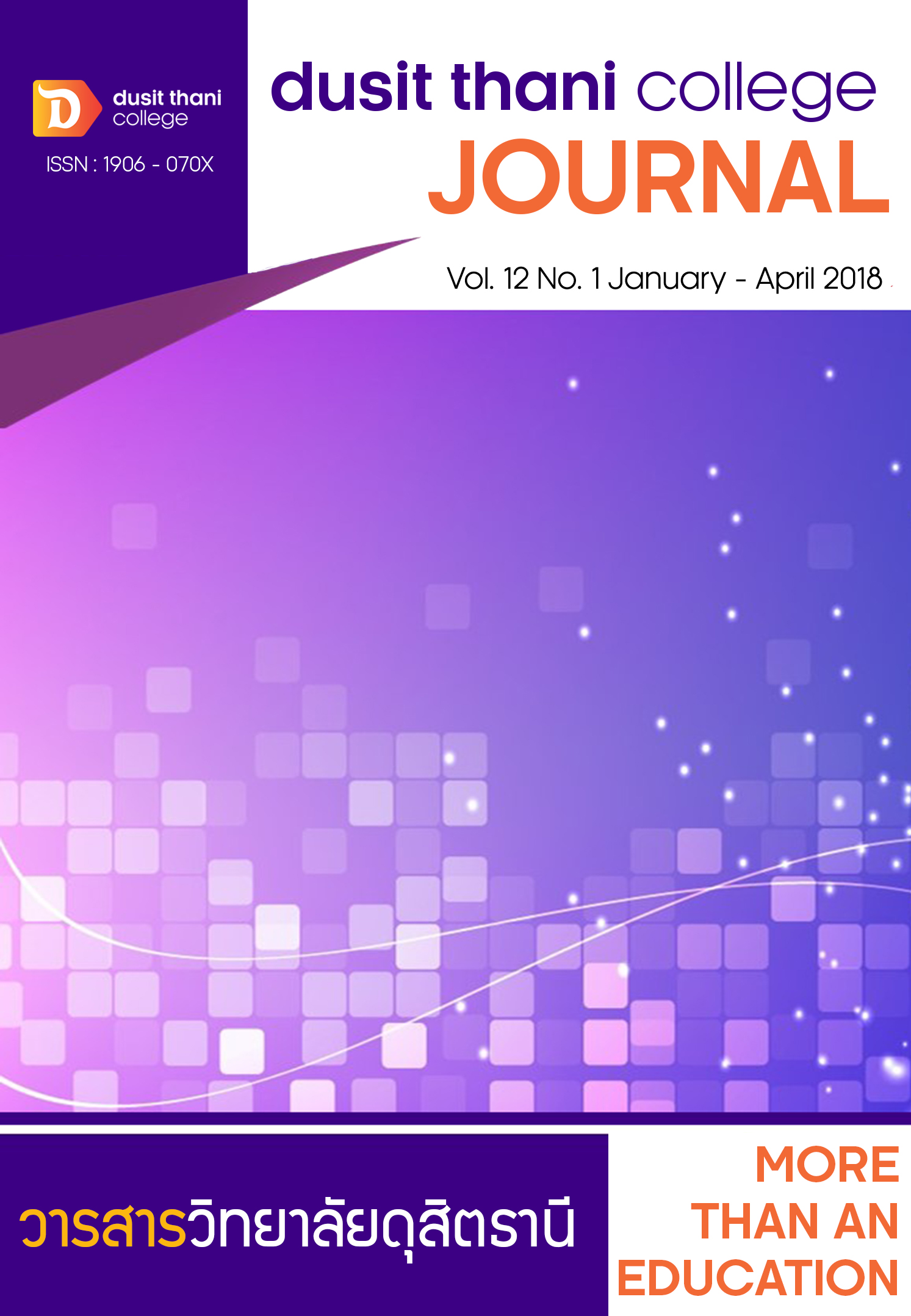Developing Program to Enhance Creative Management Toward Occupational Health and Safety Management in Hotel Business
Main Article Content
Abstract
การวิจัยนี้มีวัตถุประสงค์ เพื่อออกแบบการพัฒนาโปรแกรมเสริมสร้างแรงผลักดันทางการบริหารเชิงสร้างสรรค์ พัฒนารูปแบบโมเดล และพัฒนาคู่มือมาตรฐานการเสริมสร้างแรงผลักดันทางการบริหารเชิงสร้างสรรค์ เพื่อมุ่งสู่วิธีการจัดการความปลอดภัยและอาชีวอนามัยในธุรกิจโรงแรม ด้วยวิธีการวิจัยเชิงปริมาณ และการวิจัยเชิงคุณภาพ ประชากรของการวิจัยเชิงปริมาณ ได้แก่ พนักงานระดับบริหารของโรงแรมระดับ 5 ดาว กลุ่มตัวอย่างได้แก่ ผู้บริหารจำนวน 280 คน ด้วยวิธีการเลือกแบบเจาะจง สำหรับผู้ให้ข้อมูลหลักของการวิจัยเชิงคุณภาพ ได้แก่ พนักงานบริหารระดับสูงจำนวน 8 คน ในการสนทนากลุ่ม และประเมินค่าความเที่ยงตรงเชิงโครงสร้างของคู่มือมาตรฐานด้วยเมตริกซ์หลายคุณลักษณะหลายวิธี (MTMM) รวมทั้งวิเคราะห์องค์ประกอบเชิงยืนยัน (CFA) จากแบบสอบถามที่พัฒนาขึ้น ผลการศึกษา พบว่า องค์ประกอบของผู้นำเชิงสร้างสรรค์มี 7 องค์ประกอบหลัก ได้แก่ วิสัยทัศน์ จินตนาการ การปรับปรุงกระบวนการปฎิบัติงาน การจูงใจ การให้ความร่วมมือ ความยืดหยุ่น และการคิดค้นสิ่งใหม่ และยืนยันขึ้นรูปเป็นโมเดล “VIP-MCFI” สำหรับพัฒนาเป็นคู่มือมาตรฐานในการพัฒนาผู้บริหารของโรงแรมไปสู่การบริหารเชิงสร้างสรรค์ เพื่อมุ่งสู่วิธีการจัดการความปลอดภัย และอาชีวอนามัยในธุรกิจโรงแรม
Article Details
Article Screening Policy
- All research and academic articles to be published must be considered and screened by three peer reviews in the relevant field / article.
- All articles, texts, illustrations and tables published in the journal are the personal opinions of the authors. Editors don't always have to agree. And no responsibility whatsoever is the sole responsibility of the author.
- The articles to be published must never be published. Where did you first publish? And not in the consideration of other journals If the audit found that there has been a duplicate publication It is the sole responsibility of the author.
- Any article that the reader sees as being plagiarized or impersonated without reference. Or mislead the work of the author Please let the journal editor know it will be your greatest blessing.
References
ASEAN OSHNET CBM. (2007). Plan of Action on National Occupational Safety and Health Framework for ASEAN. Singapore: ASEAN OSHNET CBM.
Bureau of Safety. (2015). Situation of Thailand Safety and Occupational Health Performance year 2015. Bangkok, Department of Welfare and Labor Protection, Ministry of Labor. Bangkok.
Bureau of Labor Safety. (2014). National Plan of Safety Occupational Health and Working Environment (2012-2016). Department of Welfare and Labor Protection, Ministry of Labor. Bangkok: Partnership Limited Bangkok Block.
Department of Tourism. (2014). Standard of accommodation for tourism – Hotel, 5 Stars, Revision1 Standard Code Mo-To-To 202, Volume 21: 2014. Ministry of Tourism and Sports. Bangkok.
Department of Welfare and Labor Protection. (2015). Training Manual Safety Officer at Management Level. Ministry of Labor. Bangkok: Reangsam Graphic Design Co; ltd.
European Agency for Safety and Health at Work. (2012). Management Leadership in Occupational Safety and Health–A practical guide. Luxembourg: Publications Office of the European Union.
Hamel, G. (2012). What matters now: How we win in a world of relentless change,ferocious competition, and unstoppable innovation. San Fransisco: Jossey-Bass.
Health and Safety Executive (HSE). (2001). Non-fatal major injuries reported to all enforcing authorities by industry 1997/98 to 2001/02p. https://www.hse.gov.uk/statistics/pdf/table4.pdf - Accessed 01.07.03.
Heifetz, Grashow, and Linsky. (2009). Leadership in a (Permanent) Crisis. Harvard Business Review.
Hospitality Industry OHS Committee. (2000). Managing Occupational Health and Safety in the Hospitality Industry Small Employers. WorkCover Corporation's Marketing & Communications Department, South Australia.
International Labor Organization. (2009). World Day for Safety and Health at Work 2009 Facts on Safety and Health at Work. International Labour Office. Geneva Switzerland.
International Labor Organization. (2014). Good Practices Guide for Guesthouse and Small Hotel. International Labour Organization Web site: https://www.ilo.org.wcmsps/groups /.../wcms_203969.pdf.
Kelley, T., & Littman, J. (2001). The art of innovation. New York: Doubleday.
Kittanawat Somsak. (2002). A Model Development to Enhance the Creative Leader for Small and Medium Entrepreneurs by Using the Principles of Organizing Activities Based on Humanist and Anthony Robbins’ Self-Empowerment. Bangkok: Chulalongkorn Press.
Morgan, D. L. & Scannell, A. U. (1998). Planning focus group. In D.L. Morgan, R.A. Kruger, and J.A. King, (Eds)., Focus Group Kits, 2. Thousand Oaks, CA: Sage.
Nares Boonchoi, et al. (2012). Strategic Plan for Developing Creative Leader of Educational Leader. Graduate School Jounal, Valaya Alongkorn Rajabhat University under the Royal Patronage, Year 6: Volume 3, September – December 2012.
Patipan Kittkhan. (2012). A Structural Equation Model of Creative Leadership for Vocational College Administrators. Graduate school, Khon Kaen University.
Qun, T. F. & Kawakami, T. (2009). The ASEAN Occupational Safety and Health Network: Good Occupational Safety and Health Practice 2008/2009. Lao PDR: ASEAN Occupational Safety and Health Network.
Rungreung Somchai and Chantuk Thirawat. (2017). Enhancing Factors for Safety, Occupational Health and Working Environment Management in Hotel Business. Graduate Studies Journal. Suan Sunandha Ratjabhat University, Year 10: Volume 1, January-June 2017. Bangkok.
Rungreung Somchai and Chantuk Thirawat. (2017). Model Developing Leader to Enhance Creativity. Veridian E - Journal, Humanities Social Science and Arts, Year 10, Volume 1, January – April 2017, Graduate College. Silpakorn University, Bangkok.
Susan Buchanan, et al. (2010). Occupational Injury Disparities in the US Hotel Industry. American Journal of Industrial Medicine 53:116–125.
Taylor, W. C. (2011). Practically radical: Not-so-crazy ways to transform your company,shake up your industry, and challenge yourself. New York: Harper & Collins.
Workmen’ s Compensation Fund. (2016). Statistic of Work Related Injury and Illness 2011-2015. Ministry of Labor.

